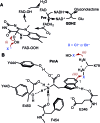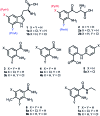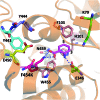Extending the biocatalytic scope of regiocomplementary flavin-dependent halogenase enzymes
- PMID: 29511510
- PMCID: PMC5659210
- DOI: 10.1039/c5sc00913h
Extending the biocatalytic scope of regiocomplementary flavin-dependent halogenase enzymes
Abstract
Flavin-dependent halogenases are potentially valuable biocatalysts for the regioselective halogenation of aromatic compounds. These enzymes, utilising benign inorganic halides, offer potential advantages over traditional non-enzymatic halogenation chemistry that often lacks regiocontrol and requires deleterious reagents. Here we extend the biocatalytic repertoire of the tryptophan halogenases, demonstrating how these enzymes can halogenate a range of alternative aryl substrates. Using structure guided mutagenesis we also show that it is possible to alter the regioselectivity as well as increase the activity of the halogenases with non-native substrates including anthranilic acid; an important intermediate in the synthesis and biosynthesis of pharmaceuticals and other valuable products.
Figures




Similar articles
-
A Structure-Guided Switch in the Regioselectivity of a Tryptophan Halogenase.Chembiochem. 2016 May 3;17(9):821-4. doi: 10.1002/cbic.201600051. Epub 2016 Mar 30. Chembiochem. 2016. PMID: 26840773 Free PMC article.
-
Structure and biocatalytic scope of thermophilic flavin-dependent halogenase and flavin reductase enzymes.Org Biomol Chem. 2016 Oct 4;14(39):9354-9361. doi: 10.1039/c6ob01861k. Org Biomol Chem. 2016. PMID: 27714222
-
Development of Halogenase Enzymes for Use in Synthesis.Chem Rev. 2018 Jan 10;118(1):232-269. doi: 10.1021/acs.chemrev.7b00032. Epub 2017 May 3. Chem Rev. 2018. PMID: 28466644 Review.
-
Genomic Determinants Encode the Reactivity and Regioselectivity of Flavin-Dependent Halogenases in Bacterial Genomes and Metagenomes.mSystems. 2021 Jun 29;6(3):e0005321. doi: 10.1128/mSystems.00053-21. Epub 2021 May 27. mSystems. 2021. PMID: 34042468 Free PMC article.
-
Enzymatic Halogenation: A Timely Strategy for Regioselective C-H Activation.Chemistry. 2017 Sep 7;23(50):12064-12086. doi: 10.1002/chem.201701209. Epub 2017 Jun 13. Chemistry. 2017. PMID: 28464370 Review.
Cited by
-
Directed Evolution of RebH for Catalyst-Controlled Halogenation of Indole C-H Bonds.Chem Sci. 2016 Jun 1;7(6):3720-3729. doi: 10.1039/C5SC04680G. Epub 2016 Feb 19. Chem Sci. 2016. PMID: 27347367 Free PMC article.
-
The Lichen Flavin-Dependent Halogenase, DnHal: Identification, Heterologous Expression and Functional Characterization.Appl Biochem Biotechnol. 2023 Nov;195(11):6708-6736. doi: 10.1007/s12010-022-04304-w. Epub 2023 Mar 13. Appl Biochem Biotechnol. 2023. PMID: 36913095
-
Going Full Circle with Organocatalysis and Biocatalysis: The Latent Potential of Cofactor Mimics in Asymmetric Synthesis.J Org Chem. 2023 Jun 16;88(12):7619-7629. doi: 10.1021/acs.joc.2c02747. Epub 2023 Apr 26. J Org Chem. 2023. PMID: 37126859 Free PMC article. Review.
-
Predicting the Substrate Scope of the Flavin-Dependent Halogenase BrvH.Chembiochem. 2020 Nov 16;21(22):3282-3288. doi: 10.1002/cbic.202000444. Epub 2020 Aug 4. Chembiochem. 2020. PMID: 32645255 Free PMC article.
-
Structure-based switch of regioselectivity in the flavin-dependent tryptophan 6-halogenase Thal.J Biol Chem. 2019 Feb 15;294(7):2529-2542. doi: 10.1074/jbc.RA118.005393. Epub 2018 Dec 17. J Biol Chem. 2019. PMID: 30559288 Free PMC article.
References
-
- Lu Y., Liu Y., Xu Z., Li H., Liu H., Zhu W. Expert Opin. Drug Discovery. 2014;7:375–383. - PubMed
-
- Jeschke P. Pest Manage. Sci. 2009;66:10–27. - PubMed
-
- Bolton O., Lee K., Kim H.-J., Lin K. Y., Kim Ji. Nat. Chem. 2011;3:207–212. - PubMed
-
- Nicolaou K. C., Bulger P. G., Sarlah D. Angew. Chem., Int. Ed. Engl. 2005;44:4442–4489. - PubMed
-
- Han F.-S. Chem. Soc. Rev. 2013;42:5270–5298. - PubMed
Grants and funding
LinkOut - more resources
Full Text Sources
Other Literature Sources

